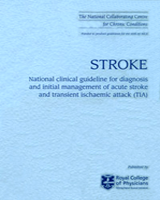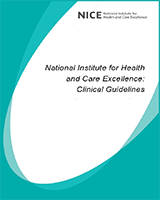All rights reserved. No part of this publication may be reproduced in any form (including photocopying or storing it in any medium by electronic means and whether or not transiently or incidentally to some other use of this publication) without the written permission of the copyright owner. Applications for the copyright owner’s written permission to reproduce any part of this publication should be addressed to the publisher.
NCBI Bookshelf. A service of the National Library of Medicine, National Institutes of Health.
National Collaborating Centre for Chronic Conditions (UK). Stroke: National Clinical Guideline for Diagnosis and Initial Management of Acute Stroke and Transient Ischaemic Attack (TIA). London: Royal College of Physicians (UK); 2008. (NICE Clinical Guidelines, No. 68.)
In May 2019, NICE updated and replaced this guideline with NICE guideline NG128 on stroke and transient ischaemic attack in over 16s. Some of the 2008 recommendations have been retained in the new guideline. This 2008 full guideline includes the evidence supporting the 2008 recommendations. Sections of the guideline CG68 that have been updated are shaded in grey in the PDF.

Stroke: National Clinical Guideline for Diagnosis and Initial Management of Acute Stroke and Transient Ischaemic Attack (TIA).
Show details1.1. Background
Stroke is a preventable and treatable disease. It can present with the sudden onset of any neurological disturbance, including limb weakness or numbness, speech disturbance, visual loss or disturbance of balance. Over the last two decades, a growing body of evidence has overturned the traditional perception that stroke is simply a consequence of aging which inevitably results in death or severe disability. Evidence is accumulating for more effective primary and secondary prevention strategies, better recognition of people at highest risk and thus most in need of active intervention, interventions that are effective soon after the onset of symptoms, and an understanding of the processes of care that contribute to a better outcome. In addition, there is now good evidence to support interventions and care processes in stroke rehabilitation. In the UK, the National Sentinel Stroke Audits2,3 have documented changes in secondary care provision over the last 10 years, with increasing numbers of patients being treated in stroke units, more evidence-based practice, and reductions in mortality and length of stay. In order for evidence from research studies to improve outcomes for patients, it needs to be put into practice. National guidelines provide clinicians, managers and service users with summaries of evidence and recommendations for clinical practice. Implementation of guidelines in practice, supported by regular audit, improves the processes of care and clinical outcome.
This guideline covers interventions in the acute stage of a stroke (‘acute stroke’) or transient ischaemic attack (TIA). Most of the evidence considered relates to interventions in the first 48 hours after onset of symptoms, although some interventions of up to 2 weeks are covered as well. This guideline is a stand-alone document, but is designed to be read alongside the Intercollegiate Stroke Working Party guideline ‘National clinical guideline for stroke’* which considers evidence for interventions from the acute stage into rehabilitation and life after stroke. The Intercollegiate Stroke Working Party guideline is an update of the 2004 2nd edition and includes all the recommendations contained within this guideline. This acute stroke and TIA guideline is also designed to be read alongside the Department of Health’s (DH) ‘National stroke strategy’ (NSS).4 Where there are differences between the recommendations made within this acute stroke and TIA guideline and the NSS, the Guideline Development Group (GDG) members feel that their recommendations are derived from systematic methodology to identify all of the relevant literature.
Stroke has a sudden and sometimes devastating impact on the patient and their family who need continuing information and support. Clinicians dealing with acute care need to be mindful of the rehabilitation and secondary care needs of patients with stroke to ensure a seamless transition across the different phases of care. All aspects of care must be patient-centred and where possible based on full discussion with the patient and/or carer, for example some aspects of the guideline may not be appropriate for patients who are dying or who have other severe comorbidities. Healthcare professionals should also follow a code of practice accompanying the Mental Capacity Act 2005 (summary available from www.dca.gov.uk/menincap/bill-summary.htm).
1.2. Incidence and prevalence
Stroke is a major health problem in the UK. It accounted for over 56,000 deaths in England and Wales in 1999, which represent 11% of all deaths.5 Most people survive a first stroke, but often have significant morbidity. Each year in England, approximately 110,000 people have a first or recurrent stroke and a further 20,000 people have a TIA. More than 900,000 people in England are living with the effects of stroke, with half of these being dependent on other people for help with everyday activities.6
1.3. Health and resource burden
In England, stroke is estimated to cost the economy around £7 billion per year. This comprises direct costs to the NHS of £2.8 billion, costs of informal care of £2.4 billion and costs because of lost productivity and disability of £1.8 billion.6
Until recently, stroke was not perceived as a high priority within the NHS. However, following the publication of the National Audit Office report in 2005, a National Stroke Strategy was developed by the DH in 2007.4 This outlines an ambition for the diagnosis, treatment and management of stroke, including all aspects of care from emergency response to life after stroke.
1.4. Definition
Stroke is defined by the World Health Organization7 as ‘a clinical syndrome consisting of rapidly developing clinical signs of focal (or global in case of coma) disturbance of cerebral function lasting more than 24 hours or leading to death with no apparent cause other than a vascular origin.’ A transient ischaemic attack (TIA) is defined as stroke symptoms and signs that resolve within 24 hours. There are limitations to these definitions. The symptoms of a TIA usually resolve within minutes or a few hours at most and anyone with continuing neurological signs when first assessed should be assumed to have had a stroke. ‘Brain Attack’ is sometimes used to describe any neurovascular event and may be a clearer and less ambiguous term to use.
Footnotes
- *
Intercollegiate Stroke Working Party. ‘National clinical guideline for stroke’, 3rd edition. London: RCP, 2008.
- Introduction - StrokeIntroduction - Stroke
Your browsing activity is empty.
Activity recording is turned off.
See more...
